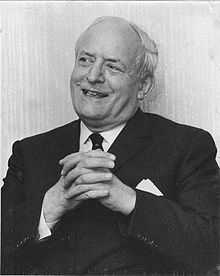Phil Vincent
| Philip Vincent | |
|---|---|
 | |
| Born |
March 14, 1908 Fulham, UK |
| Died |
March 27, 1979 (aged 71) Ashford, Middlesex |
| Residence | England, U.K. |
| Nationality | British |
| Occupation | Motorcycle designer and manufacturer |
| Spouse(s) | Elfrida Vincent |
| Children | One daughter, Deirdre |
Philip Conrad Vincent was a British motorcycle designer and manufacturer. Founder of Vincent Motorcycles, his designs influenced the development of motorcycles around the world.
Early life
Philip Conrad Vincent was born in Wilbraham Gardens, Fulham on 14 March 1908. His mother, Ada Vincent, travelled back from Argentina to have her children in order to secure British citizenship. The family owned a cattle ranch between Monte Buey and Monte Maize, in the province of Córdoba, Argentina. His education began at St. George's, a British Preparatory School in Quilmes, a suburb of Buenos Aires. He was sent back to England to live with his uncle, John Vincent, who was a veterinary surgeon and lived at High House, Horndon on the Hill, Essex. Phil's education was continued there together with his two sisters, Gwendoline & Marjorie, a cousin and four other local children. He spent a year at Downsend Preparatory School, Leatherhead. He was then accepted at Harrow School which was where he first became interested in motorcycles.[1]
Phil bought his first motorcycle, a secondhand 350cc BSA from Gamages in Holborn[1] at Christmas 1924. He went to Cambridge University in October 1926 to read Mechanical Sciences at Kings College. His real interest was in motorcycles and by the age of 18 he had a workshop and was designing and building his own machines. His father agreed that he could have a break from university to develop his first "Vincent Special". In 1928 he had registered a patent for his design of cantilever rear suspension and left Cambridge before graduating.[1]
Business

Philip formed his first company with Frank Walker, a family friend.[1] Howard R Davies, founder of the HRD marque and winner of the 1924 Senior Isle of Man TT was in financial difficulties and in 1928 with backing from his family and their cattle ranching business, Phil was able to acquire the trademark, goodwill and remaining HRD spares for £450. The company was promptly named Vincent HRD Co., Ltd., and the logo appeared with Vincent in very small letters over the top of the bold HRD. Vincent designed a brand new motorcycle with his own spring frame and marketed it as Vincent HRD, with a choice of either JAP or Rudge engines.
In 1928, the first Vincent-HRD motorcycle used a JAP single-cylinder engine in a Vincent-designed cantilever frame. The earliest known example is in Canberra, Australia. Some early bikes used Rudge-Python engines. But after a disastrous 1934 Isle of Man TT, with engine problems and all three entries failing to finish, Phil Vincent (with Phil Irving) decided to build their own engines. In 1935 the first Vincent powered motorcycle, The 499 cc Comet model was launched. It was quickly followed by the 998 cc Series A Rapide in 1936. During the war motorcycle production ceased. At the cessation of hostilities Phil Vincent and Phil Irving designed the Series B twin engine which powered the Series B Rapide and went on to power the legendary Vincent Black Shadow and Black Lightning models. In 1949 the HRD logo was dropped to prevent confusion with the "HD" of Harley Davidson in the important American Market.[2]
Phil Vincent also experimented with three-wheeled vehicles, amphibious vehicles, and automobiles. In 1932 the first 3-wheeler, "The Vincent Bantam" appeared, powered by a 293 cc SV JAP or 250 cc Villiers engine. It was a 2.5 cwt delivery van with a car seat and a steering wheel. The Bantam cost £57-10-0 and the windscreen and hood option cost £5-10-0. Production ceased in 1936.[3]
Later life
Philip Conrad Vincent died in 1979 at Ashford Hospital in Middlesex following a long illness. His ashes are interred in the family plot at St. Peter and St. Paul's Church, Horndon-on-the-Hill, Essex.
See also
References
- ↑ 1.0 1.1 1.2 1.3 "Philip Conrad Vincent". Retrieved 22 November 2008.
- ↑ "My Vincent". Retrieved 22 November 2008.
- ↑ "Vincent". 3-Wheelers.com. Retrieved 22 October 2006.
The Vincent HRD Story. Roy Harper. Vincent Publishing Company 1975
PCV: The autobiography of Philip Vincent. Vincent Publishing Company 1976